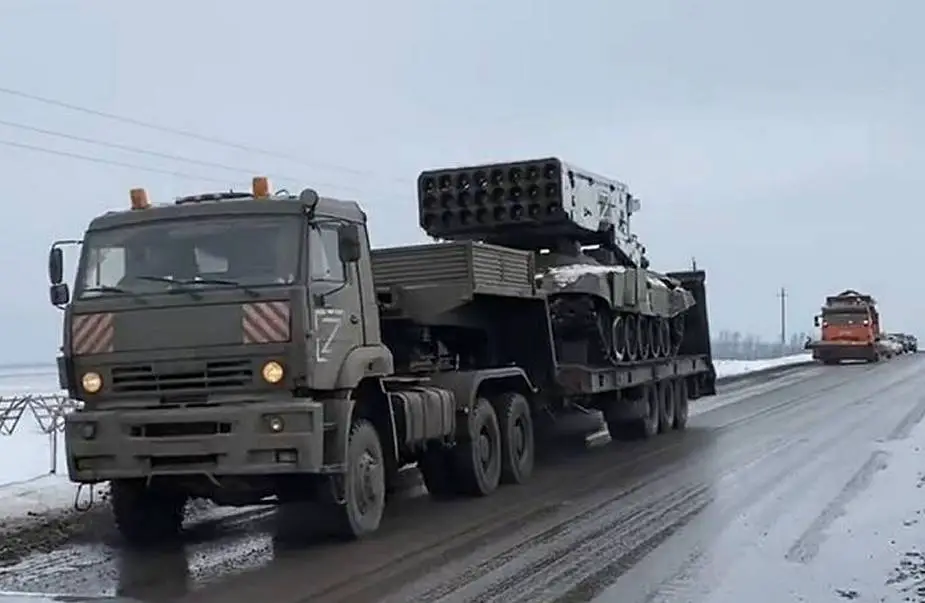As reported by David Vergun from the U.S. Department of Defense on April 18, there are now 76 Russian battalion tactical groups in the Donbas region of Ukraine and in the country's southeast. About 11 of those were added over the last several days, a senior Defense Department official said. So-called BTGs are typically composed of combined-arms elements, such as air defense, armor, tactical vehicles, artillery, helicopters, engineering and logistical support.
Follow Army Recognition on Google News at this link

Besides the 76 Russian BTGs (battalion tactical groups), there are about 22 BTGs north of Ukraine that are likely being resupplied and refitted (Picture source: Twiter account of Frederik Pleitgen)
Besides the 76 BTGs (battalion tactical groups), there are about 22 BTGs north of Ukraine that are likely being resupplied and refitted, the official said. About a dozen of those inside Ukraine are trying to take Mariupol, an important port on the Sea of Azov: "Our assessment in Mariupol is still contested," the official said. The city remains under threat from heavy Russian air strikes and artillery.
Should Mariupol fall to the Russians, that would free the dozen or so BTGs to be used elsewhere in the east or south of Ukraine, the official said. "That's a big if because the Ukrainians are still fighting very, very hard for Mariupol."
The Ukrainians have reported that they believe Russia is preparing to land Russian marines in the vicinity of Mariupol. "We can't confirm that independently, but we're certainly not in a position to dispute it," the official said.
Further to the west of Mariupol is another important port city: Mykolayiv. Over the last several days, it has been subject to Russian bombardment from airstrikes and artillery, the official said.
Just to the west of Mykolayiv is the port city of Odesa, which is also important. "We still assess that the Russian navy is maintaining a standoff distance from Odesa, not getting very close in the wake of the Moskva sinking," the official said. The Russian guided-missile cruiser Moskva is believed to have been sunk by Ukrainian Neptune missiles several days ago.
The Russians do have some amphibious capability in the Black Sea and in the Sea of Azov, the official said. The Russians have at least one tank landing ship in the Sea of Azov that's capable of landing Russian marines, and there are others of the same class of vessels in the Black Sea. Thus far, there are no indications that an amphibious assault is imminent, the official said.
In the north, the Russians continue bombing in the vicinity of Kharkiv as Russian forces blockade the city. In the Joint Forces Operation of the Donbas region of Ukraine, the heaviest fighting is around a town called Popasna. Fighting also continues to the south and the southeast of the Ukrainian city of Izyum, the official said: "The Donbas region has been a hot war for eight years. Both sides have traded geography with some violence over the last eight years, and the Ukrainians do have a not insignificant force posture there, and they are fighting," the official said.
Elsewhere, Russian long-range bombers have executed cruise missile strikes on both Ukraine's capital, Kyiv, and the city of Lviv in Ukraine's far west over the last couple of days. The Pentagon's assessment is that they are going after primarily military targets or what they believe to be military targets, the official said.
In other news, U.S. Army and Marine Corps 155 mm howitzers that are in the United States have been earmarked for Ukraine and will be shipped soon, the official said. Since Ukrainian armed forces are not familiar with this type of artillery, there will be training to "train-the-trainer" for Ukrainians outside of Ukraine in the coming days, the official said.
It is noted that the Russians are training additional units of the northern fleet and the 8th combined army of the southern military district of the Russian Armed Forces to conduct hostilities in Ukraine. In order to provide units with military equipment, measures are being taken to remove military equipment from long-term storage in warehouses.
The situation in the Volyn and Polissya directions remains unchanged. There is a movement of units of the 36th combined arms army of the eastern military district by rail from the Gomel region of the Republic of Belarus. The threat of missile strikes from the territory of Belarus on the objects of Ukraine remains.
In the Siverskyi direction, the enemy is regrouping units, accumulating them in the areas bordering Ukraine. From the territory of the Briansk and Kursk regions, there is a movement to the Belgorod and Voronezh regions of Russia.
In the Slobozhanskyi direction, the Russian army is conducting reconnaissance of possible directions of offensive, increasing the system of reconnaissance and medical support. The Russians are also replenishing their reserves.
Partial siege and shelling of Kharkiv continue.
Russians continue building up forces in the areas of Sloviansk and Barvinkove settlements.
In the Donetsk direction, the Russian army, with the support of air force and artillery, continues offensive in certain directions. The main efforts are focused on establishing control over the settlements of Popasna, Rubizhne, Severodonetsk and Sloviansk.
The enemy tried to break through the Ukrainian defenses in the areas of Rubizhne, Novotoshkivske and Marinka, but was repelled by the Ukrainian army. Russian forces continued to launch air strikes on Mariupol.
The situation in the South Bug direction remained unchanged.
As Ukrinform reported, from February 24 to April 14, Russian forces lost about 19,900 personnel.














